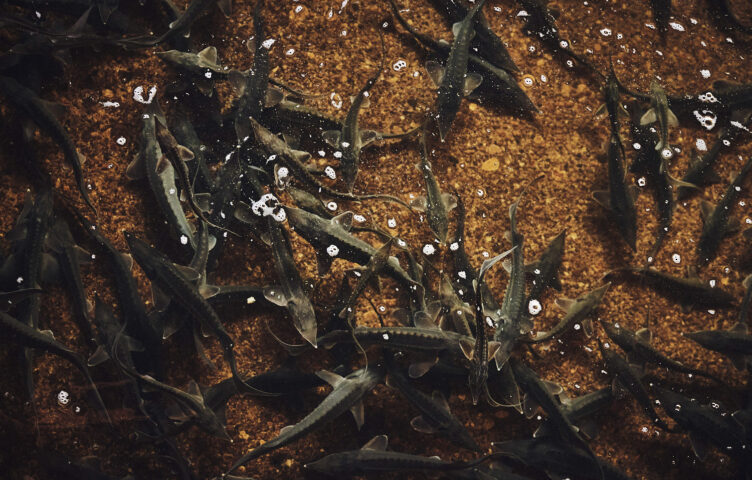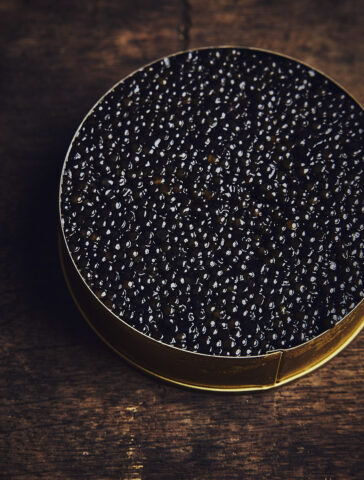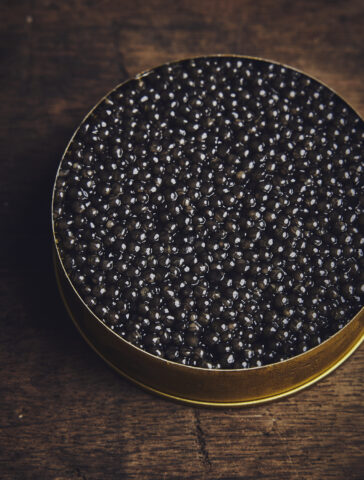What is caviar?
How is caviar produced?
Caviar is a product made from the eggs of the sturgeon.
It is an exceptional delicacy, a star product of French fine dining and cuisine.
In this new article, we invite you to discover the different types of Kaviari caviar.
Beluga, French Baeri, Transmontanus, there are several varieties of caviar, each with its own specific characteristics.
Ready for a treat?
What is caviar?
Caviar is an exceptional product made from sturgeon roe. The roe of this fish are refined and matured to give caviar its unique and exceptional texture, flavor and quality.
The sturgeon is a fish of the Acipenseriformes family. Large in size, its elongated, subcylindrical body can measure up to 3.50 meters and weigh up to 500 kilos. This fish has no scales, but cartilaginous plates called “scutes” or bony escutcheons, the number and configuration of which determine the species. They can live up to 100 years! This longevity also explains the length of its puberty, from 8 to 20 years depending on the variety.
There are at least 26 varieties of sturgeon in the world. Today, only 9 species have been selected for breeding. At Kaviari, these include: Baeri, Ossetra, Transmontanus, Kristal®…
Caviar in the past
In the past, the Caspian Sea was the main source of all caviar. Wild caviar was 90% sourced from the Caspian Sea. Threatened with extinction, the sturgeon was classified as a protected species by CITES (Convention on International Trade in Endangered Species of Wild Fauna and Flora, also known as the Washington Convention). The end of wild caviar.
To preserve the species, producers are turning to breeding sturgeon in the wild on fish farms.
France, for example, is home to one of the most famous sturgeon farms in the world: the Sologne farm, where the Baeri sturgeon is cultivated. French Baeri caviar (only available on the French boutique) is appreciated for its iodized, earthy flavors, with hints of dried fruit on the finish.

Focus on oscietra caviar
Mythical and omnivorous, this sturgeon of Russian origin was the fish which gave, in the wild, the most variable eggs. Medium in size, the Acipenser gueldenstaedtii measures 1.5 to 2 meters, and weighs between 50 and 100 kilos. At the time of wild caviar, it represented approximately 30% of Iranian caviar.
The Ossetra produces eggs after a minimum of 9 years.
Its amber grains with anthracite or golden highlights are of good size and regular. It produces a creamy caviar with marine, delicately salty and nutty flavors.
Focus on beluga caviar
The wild Beluga was by far the largest fish of the species. Gigantic and promising an extraordinary harvest of caviar, this “elephant fish” is the gem of which all Caspian Sea fishermen dreamed.
Originally from the Danube, the Beluga is now only bred on a few farms, as it takes patience – at least 18 to 20 years! – to produce their first eggs.
This fish could grow to over 5 or 6 meters in length.
Available in shades of gray, its grains are characterized by a very fine membrane, buttery notes and a unique length in the mouth.

Many sturgeon-rich rivers, such as the Volga and the Urals, flow into the Caspian Sea. These rivers, which form very flat estuaries, make good spawning grounds. The main species was Acipenser baerii, the Siberian sturgeon.
The Acipenser Baeri is a sturgeon that can grow up to 3 meters long. It measures between 0.50 and 1 meter, and weighs between 7 and 20kg. This species is mainly bred in France, and is now the most widespread of all breeds.
This sturgeon produces firm, dark ebony-gray grains. On the palate, caviar is recognized by its iodized, earthy flavors, with hints of dried fruit on the finish.

